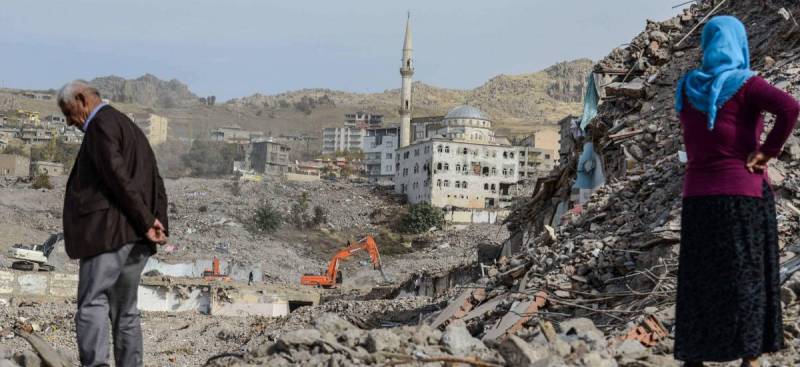Turkish President Recep Tayyip Erdoğan said on Oct. 18 that the Kurdish-majority southeastern province of Şırnak has the same benefits as the country’s 80 other provinces.
“What exists in Turkey’s 80 other provinces in the name of democracy, rights and freedoms exists here,” Erdoğan said during a congress of his ruling Justice and Development Party (AKP) in the province.
“We serve on the basis of democracy and development for everyone. We have been doing in Şırnak what we have been doing for Turkey’s development since we came to power,” he added.
“If you are subjected to the slightest discrimination in terms of both democracy and development, it is my duty to bring the responsible ones to account,” he said.
Now let me explain to you the Şırnak I know, and you can decide whether Şırnak has what the other 80 provinces of the country have.
The curfew announced in Şırnak on March 14, 2016, lasted about 8 months and was only partially lifted in November.
Following the break down of the peace process between the Turkish state and the Kurdistan Workers’ Party (PKK) in 2015, Turkey sent armed forces to fight Kurdish insurgents in urban centres, enforcing strict curfews and often leaving large parts of the cities destroyed.
According to a report by the Human Rights Foundation of Turkey, a total of 299 curfews were implemented in 11 provinces and at least 49 towns between Aug. 16, 2015 and March 1, 2018. A total of 169 of these curfews were in Diyarbakır, 48 in Mardin, 23 in Hakkari, six in Batman, two in Elazığ, and four in Siirt, all Kurdish-majority provinces.
I could not enter Şırnak while the curfew was still in force in 2016. But I noticed a banner at the city entrance: “Şırnak is one of 81 provinces of Turkey”. I headed towards the surrounding villages instead. There were tents everywhere on the hills, by the roads and around the villages. The people of Şırnak, who were forced to flee the conflict, were scattered everywhere. Since local officials could not enter the city, they were trying to help people in neighbouring towns and villages.
After the curfew was partially lifted, I went to Şırnak again in January 2017. There was a long queue of vehicles and the cars were moving very slowly. After waiting for a while, I decided to leave my vehicle somewhere and enter Şırnak on foot. It was as if we were entering another country, crossing a border, with wire fences and platforms at the entrance to the city.
The banner at the city’s entrance had also changed. This time it read: “Şırnak is a Turkish Province”. Immediately upon entering, there were things taken from demolished houses lying on the empty land between a police security point and Şırnak University. These items were separated, refrigerators in one place, air conditioners in another… The belongings of the people of Şırnak were being sold as second-hand goods by the firm that won the tender to demolish the city.
A huge void greeted me. We walked through it for a long time. Then I asked my host: “Where is the centre of the city, where is the bazaar?”. I had been heedless to ask. That big, vast void was apparently the city’s centre. There was almost nothing left. Şırnak, as we know it, had disappeared. I remember sitting down on one of the stones and crying.
I visited Şırnak frequently between 2017 and 2018. In those years, the city turned into a construction zone. The Housing Development Administration of Turkey (TOKİ) was building huge housing estates. Bulldozers were all over Şırnak. When you woke up in the morning, the sound of diggers was mixed with roosters. Towards the end of 2018, there was another Şırnak now. Twelve-storey TOKI buildings were rising from everywhere. A government-appointed official was ruling the city in place of the democratically elected mayor.
The trustee was very interested in the city’s appearance. Flowers were planted in the centres, elegant lighting was placed in the streets, grass was planted, on some wide walls on the streets it was written: “Devoted to artistic works”. But with the rising TOKI residences, Şırnak was rapidly losing its colours and diversity. The political pressure was high, the people of Şırnak were afraid to speak to me. A villager whispered in my ear: “Şırnak has had its second deluge after Noah”.
Today, there is another Şırnak in every sense. When those who know the old Şırnak die, the city we lost will not even be held in memories. The main street rising windingly upward, the tea garden on the hill across from the Cudi and Gabar mountains, and the old Şırnak consisting of two-storey houses with gardens. It hurts me to know that they are all gone.
Şırnak was a Kurdish city. Some 70 percent of the city was demolished after the eight-month clashes and curfew. Seven major neighbourhoods were completely destroyed. Sixty-four thousand residents were displaced. Although five years have passed, tens of thousands of Şırnak residents are still homeless and have not managed to return to their homeland. Even today, it is not known exactly how many people died during the curfews. After five years, some of the bodies are still lost.
